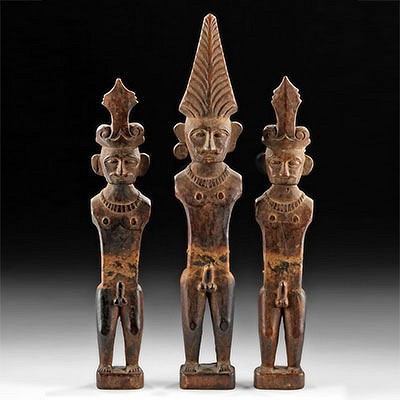Roman Lead Votary of Jupiter
Lot 42b
About Seller
Artemis Fine Arts
686 S Taylor Ave, Ste 106
Louisville, CO 80027
United States
Selling antiquities, ancient and ethnographic art online since 1993, Artemis Gallery specializes in Classical Antiquities (Egyptian, Greek, Roman, Near Eastern), Asian, Pre-Columbian, African / Tribal / Oceanographic art. Our extensive inventory includes pottery, stone, metal, wood, glass and textil...Read more
Categories
Estimate:
$700 - $900
Absentee vs Live bid
Two ways to bid:
- Leave a max absentee bid and the platform will bid on your behalf up to your maximum bid during the live auction.
- Bid live during the auction and your bids will be submitted real-time to the auctioneer.
Bid Increments
| Price | Bid Increment |
|---|---|
| $0 | $25 |
| $300 | $50 |
| $1,000 | $100 |
| $2,000 | $250 |
| $5,000 | $500 |
| $10,000 | $1,000 |
| $20,000 | $2,500 |
| $50,000 | $5,000 |
| $100,000 | $10,000 |
| $200,000 | $20,000 |
About Auction
By Artemis Fine Arts
Jun 25, 2020
Set Reminder
2020-06-25 10:00:00
2020-06-25 10:00:00
America/New_York
Bidsquare
Bidsquare : CLEARANCE - Ancient, Pre-Columbian, Ethno Art
https://www.bidsquare.com/auctions/artemis-gallery/clearance---ancient-pre-columbian-ethno-art-5264
Featuring discounted pricing on antiquities from Egypt, Greece, Italy, and the Near East...plus Viking, Asian, Pre-Columbian, Tribal, Russian Icons, Spanish Colonial, Fine Art, more! Starting prices have been reduced up to 65% from original auction prices - perfect for dealers and collectors. Artemis Fine Arts info@artemisfinearts.com
Featuring discounted pricing on antiquities from Egypt, Greece, Italy, and the Near East...plus Viking, Asian, Pre-Columbian, Tribal, Russian Icons, Spanish Colonial, Fine Art, more! Starting prices have been reduced up to 65% from original auction prices - perfect for dealers and collectors. Artemis Fine Arts info@artemisfinearts.com
- Lot Description
**First Time At Auction**
Roman, Imperial Period, ca. 2nd to 3rd century CE. A fascinating lead votive depicting an ancient mystery cult version of Jupiter - either Jupiter Heliopolitanus (the local god of Heliopolis; modern Baalbek, Lebanon) or Jupiter Dolichenus (the local god of Doliche in Commagene; modern Duluk, Turkey) - from the great period of the mystery religions when the Romans imposed the Pax Romana upon the Mediterranean world. The deity stands atop a platform supported by two bulls, the reins in his outstretched left hand, a crop/whip in his raised right hand. Jupiter faces forward with an abstract visage and features characteristic of the so-called "oriental gods" of the mystery cults. He is dressed in military fashion, highly decorated with jewelry and a stylized crown. Scholars believe that worshippers placed votive plaques like this one within special sites - i.e. temples, springs, and wells - of Heliopolis and Doliche. A rare and intriguing artifact from this period. Size: 2.4" W x 3.45" H (6.1 cm x 8.8 cm); 4.55" H (11.6 cm) on included custom stand.
The cult of Jupiter Heliopolitanus originated in ancient Heliopolis, modern day Baalbek in Lebanon, and spread to the western provinces of the Roman Empire during the first half of the 2nd century. Images of the deity have only survived from the Roman Imperial period, as we have no renderings that date prior to the first half of the 1st century BCE. The Temple of Jupiter served as an oracle and was dedicated to Jupiter Heliopolitanus. It is the largest temple of the Roman world, situated at the Baalbek complex in Heliopolis Syriaca.
The cult of Jupiter Dolichenus rose to popularity during the 2nd century and reached its apex in the early 3rd century during the Severan dynasty. We know of 19 temples erected to Jupiter Dolichenus - far fewer than those dedicated to honor other "oriental" deities such as Cybele, Mithras, or Isis. This god was thought to be an evolution of an eastern deity - in this case derived from a Semitic Hadad-Baal-Teshub cult which was centered on a hill near Doliche - hence the name Jupiter Dolichenus (meaning of Doliche). The Romans perceived this deity as Syrian with links to Baal's role as a king of his pantheon, akin to Jupiter.
Provenance: ex-Phoenicia Holyland Antiquities; ex Collection of Mr. Khabbazi, November 1992
All items legal to buy/sell under U.S. Statute covering cultural patrimony Code 2600, CHAPTER 14, and are guaranteed to be as described or your money back.
A Certificate of Authenticity will accompany all winning bids.
We ship worldwide and handle all shipping in-house for your convenience.
#155756Intact, with very nice preservation of details and light deposits in the lower profile areas.Condition
- Shipping Info
-
All shipping is handled in-house for your convenience. Your invoice from Artemis Gallery will include shipping calculation instructions. If in doubt, please inquire BEFORE bidding for estimated shipping costs for individual items.
-
- Buyer's Premium



 EUR
EUR CAD
CAD AUD
AUD GBP
GBP MXN
MXN HKD
HKD CNY
CNY MYR
MYR SEK
SEK SGD
SGD CHF
CHF THB
THB














